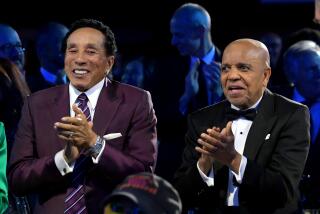Jazz Legend Retires His Reeds
- Share via
The Swing King was still a young man when he retired in 1954.
On Thursday, legendary band leader Artie Shaw, now 93, retired two of his beloved clarinets, giving them to the Smithsonian’s National Museum of American History.
For the record:
12:00 a.m. Aug. 30, 2003 For The Record
Los Angeles Times Saturday August 30, 2003 Home Edition Main News Part A Page 2 National Desk 2 inches; 70 words Type of Material: Correction
Artie Shaw -- An article about former bandleader Artie Shaw that ran in some editions of Friday’s California section misquoted John Hasse, curator of American music at the Smithsonian’s National Museum of American History, when he said that many believed Shaw “was among the most accomplished and innovative of all jazz musicians.” Hasse actually said many believed that Shaw “was among the most accomplished and innovative of all jazz clarinetists.”
During a ceremony in Westlake ViIlage near his home, the wheelchair-bound Shaw was presented with the James Smithson Bicentennial Medal for his contributions to music.
“Many of us think Artie Shaw was the most accomplished and innovative of all jazz musicians,” John Hasse, curator of American music at the Smithsonian, said as he handed the award to the famed clarinetist.
Outfitted in a black print shirt and a baseball cap, Shaw, best known for his recording of “Begin the Beguine” in 1938, was jaunty as ever as he addressed the audience.
“People ask, ‘What’s the difference between Benny Goodman and me?’ Well, I’m alive,” Shaw quipped.
One of the two clarinets he donated to the museum was the one he played when recording “Beguine,” which sold more than 1 million copies. Asked what was so special about the instrument, Shaw was quick to respond, “It’s not the clarinet, it’s me.”
In fact, the alto saxophone, not the clarinet, was his first instrument. Shaw explained why he made the switch: “I was playing and recording in studios around New York -- we had to run from program to program -- and I was always having to run around with my sax, and, well, the clarinet weighs less.”
As a teenager, Shaw listened to Louis Armstrong recordings and other “race” records, as recordings by black musicians were called at the time. In the 1930s, he began paying more attention to classical composers such as Stravinski, Bartok and Ravel.
He responded by putting together a small but unusual group of musicians that combined jazz instruments with a string quartet. Although some critics loved the results, swing jazz was what the public wanted to hear.
During the ‘30s, Shaw and his swing bands hit their stride, rivaling Goodman’s bands for their vigorous playing and breathtaking solos. He climbed the charts with recordings of “Stardust,” “Frenesi” and “Moonglow.” He was also one the first white band leaders to hire a black vocalist -- Billie Holiday.
So popular was his music that on the eve of World War II, Time magazine declared that to the Germans, the United States meant “skyscrapers, Clark Gable and Artie Shaw.”
But it was that very fame that drove him from performing in 1954 at the age of 44. Disgusted with the exploits of the McCarthy era, Shaw eventually left for Europe.
“I could no longer stand the fulminating of that man, so I went to Spain,” he said. “Five years later, someone told me, ‘It’s better now,’ so I came home, and the first thing I heard was Lawrence Welk on TV.” Over the years, Shaw has devoted much of his time to reading -- his personal library includes 15,000 volumes -- and a writing career, which has included several novels, short stories and a semiautobiographical work entitled “The Trouble with Cinderella.”
The Thousand Oaks resident is working on an autobiographical novel that he calls “The Education of Albie Snow.” In recent years, he has also helped compile a five-CD boxed set of selected pieces from his musical career.
His hearing nearly gone now, Shaw said he couldn’t enjoy listening to music these days. But he reminded the audience Thursday that while he retired from performing nearly 50 years ago, he never really retired.
“This ceremony is a crowning thing,” he said. “But I’ve still got things to do.”
More to Read
The biggest entertainment stories
Get our big stories about Hollywood, film, television, music, arts, culture and more right in your inbox as soon as they publish.
You may occasionally receive promotional content from the Los Angeles Times.









